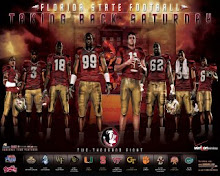In football, heat exhaustion is a dangerous reality. As we have seen in the last few days, FSU football players are dealing with a heat index well over 100 degrees. On top of all the pads and the sweltering heat—or underneath, to be more precise—are players who weigh over 300 pounds. Due to their body mass, these players, who generally serve as offensive and defensive linemen, face a high risk of suffering from heatstroke. Even players in top shape can be at high risk for a variety of reasons including if they reach critical dehydration because they sweat out fluids without properly replenishing. That is why a good strength and conditioning coach who monitors the players closely is vital.
Due to the concerns regarding heat,the NCAA has rules regarding preseason practice. The first three days are to be a conditioning period and the players are only allowed to wear T-shirts/jersey, shorts, shoes, helmets, and shoulder pads. On days that have multiple practice sessions, players must be provided with at least three continuous hours of recovery time between the end of the first and the start of the last practice that day. And in yet another development, there is technology to assist with the problem of heat. University Applied Physics Laboratory worked closely with Goddard Space Flight Center(NASA) to develop the Ingestible Thermal Monitoring System. The resulting ¾-inch capsule consisted of a silicone coating on the exterior and a telemetry system, a microbattery, and a quartz crystal temperature sensor on the interior.
And in yet another development, there is technology to assist with the problem of heat. University Applied Physics Laboratory worked closely with Goddard Space Flight Center(NASA) to develop the Ingestible Thermal Monitoring System. The resulting ¾-inch capsule consisted of a silicone coating on the exterior and a telemetry system, a microbattery, and a quartz crystal temperature sensor on the interior.
Once ingested and inside the gastrointestinal tract, the quartz crystal sensor vibrates at a frequency relative to the body’s temperature, producing magnetic flux and transmitting a harmless, low-frequency signal through the body. This signal can then be retrieved by a recorder, outside of the body, that displays the core body temperature reading with an accuracy to within one-tenth of a degree, Celsius.
Within 1 to 2 hours of ingesting, the CorTemp thermometer pill will reveal vital information necessary for the prevention and treatment of heat-related illnesses. (It will remain in an individual’s system for 18 to 30 hours, before passing safely.) The absence of catheters, probes, and wire connections allow team physicians and certified athletic trainers (ATCs) to noninvasively and wirelessly monitor the core body temperature of multiple athletes in real time during field play or practice. These medical professionals have several options and configurations for tracking athletes. The simplest is direct manual monitoring, whereby they hold the CorTemp Data Recorder (a physiological monitoring system) near the small of an athlete’s back.
The University of Florida has tried out the technology, as has the University of Connecticut, the University of Oklahoma, and West Chester University (Pennsylvania), all under a National Collegiate Athletic Association (NCAA)-sponsored study that has led to the development of new guidelines regarding the amount of time players can practice and the amount of padding they can wear during hot summer days.
In the NFL, the Jacksonville Jaguars, Philadelphia Eagles, and Minnesota Vikings are using the technology to monitor their players. According to published reports, all three teams are pleased with how the sensor pill is keeping their players safe from the heat. HQ, Inc., is currently talking with several other professional football teams about investing in its products.
Twitter Updates
Wednesday, August 08, 2007
Rules And Technology Helping To Beat Heat
Posted by
tallynolefan
at
4:45 PM
![]()
Subscribe to:
Post Comments (Atom)







No comments:
Post a Comment